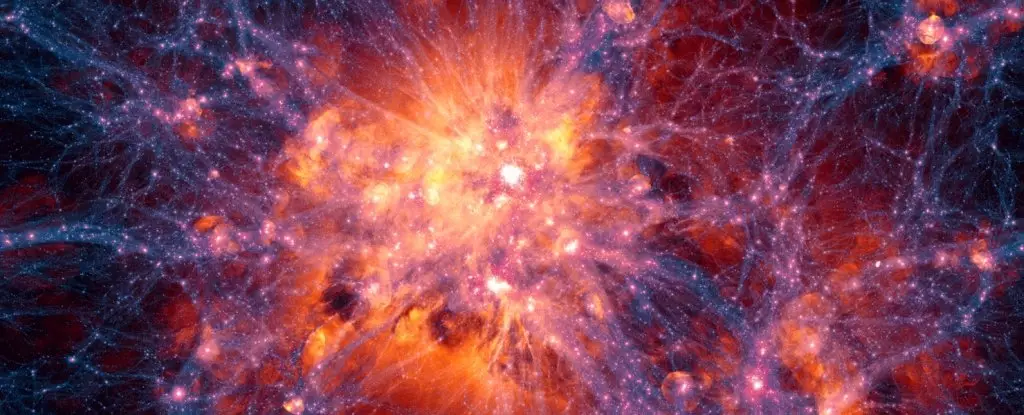Albert Einstein’s theory of general relativity has stood the test of time, proving itself as a foundational pillar of modern physics. Developed in the early 1900s, it fundamentally reshaped our understanding of gravity and the fabric of space-time. A recent landmark study involving nearly six million galaxies over 11 billion years of cosmic history bolsters the theory’s credibility, revealing how gravity governs the formation and clustering of these galaxies along interconnected strands often referred to as the “cosmic web.” This monumental research suggests that not only does gravity hold sway over large chemical structures, but it does so in a manner consistent with Einstein’s original predictions.
The intricate mapping of galaxies has unveiled a coherent narrative about the universe’s evolution, showcasing how gravity influences the distribution of matter over the eons. Conducted by a collaborative consortium of astronomers, this study serves as one of the largest tests of general relativity to date. It scrutinizes how gravitational forces orchestrate the clumping of galaxies, countering the universe’s expansion. According to cosmologist Pauline Zarrouk, the findings affirm our understanding of cosmic structures across massive scales, reinforcing general relativity’s predictions.
From a scientific standpoint, this inquiry into the cosmic web represents not only validation of a century-old theory but also offers insights into fundamental questions about the interplay of forces governing cosmic dynamics. It becomes abundantly clear that our understanding of gravity is critical to deciphering the universe’s complex architecture, and the implications stretch beyond our immediate perceptions of reality.
The essence of gravity remains one of the universe’s great enigmas. While it is universally acknowledged as the force that fosters attraction among objects of mass, the underlying mechanics and origins of this phenomenon invite ongoing exploration. As scientists piece together the mystery of dark matter and its role in the gravitational tapestry, they confront questions that probe the very boundaries of contemporary physics. Large-scale structures within the universe are primarily defined by the strands of this cosmic web, with dark matter functioning as a glue that binds them together. The consistency of these observations with Einstein’s predictions indicates not just a verified theory but a pathway to understanding deeper cosmic mysteries.
Continued scrutiny of general relativity could lead to transformative insights into unresolved debates in physics, particularly the gap that exists between quantum mechanics and classical theories. Researchers conduct rigorous examinations of the universe’s composition to determine whether deviations from general relativity exist, holding the potential to elucidate outstanding enigmas in modern science.
At the forefront of this exploratory endeavor is the Dark Energy Spectroscopic Instrument (DESI), a remarkable tool spearheaded by the Lawrence Berkeley National Laboratory. Launched in 2019, DESI aims to systematically map the observable universe, employing its capabilities to unravel the secrets of dark energy and dark matter. Focusing on a detailed survey of 5.7 million galaxies and quasars, DESI’s initial data—an outcome of meticulous analysis—confirms that cosmic structures expand in accordance with the predictions of general relativity.
The significance of this work cannot be understated. Physicist Dragan Huterer articulates the project’s ambitious goal to refine our understanding of dark energy and modified gravity, indicating that this groundbreaking research represents merely the dawn of its potential.
As DESI continues to gather and analyze data over its operational span, anticipation abounds regarding the revelations that may emerge. With plans to study over 40 million galaxies and quasars, the collaboration seeks to deepen our insights into dark matter and dark energy—elements constituting about 95% of the universe that remain poorly understood. This opportunity to photograph the cosmos represents not only a scientific milestone but a profound chance to answer fundamental questions about our existence.
Mark Maus from the Lawrence Berkeley National Laboratory aptly summarizes the potential impact of these findings, acknowledging the extraordinary endeavor of visualizing and conceptualizing our universe’s complex dynamics. As research progresses, the possibilities of illuminating shadowy areas of physics increase, potentially leading to a paradigm shift in how we grasp the universe.
The enduring nature of Einstein’s general relativity serves as a testament to the intricacies of the universe, reminding us that while progress is made, many mysteries await our exploration. As researchers continue to probe cosmic forces and chart the depths of the observable universe, each new insight builds upon the formidable foundation laid over a century ago. Indeed, the cosmos harbors a wealth of undiscovered knowledge, and perhaps with ongoing diligence, humanity will move closer to unlocking its profound secrets.


Leave a Reply